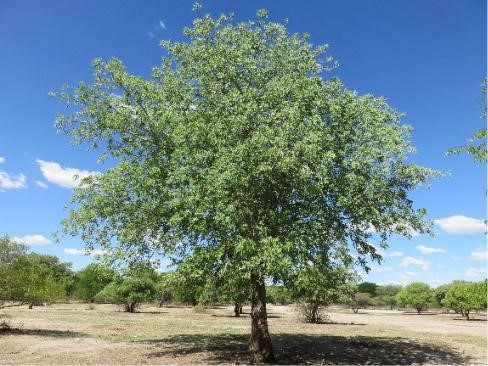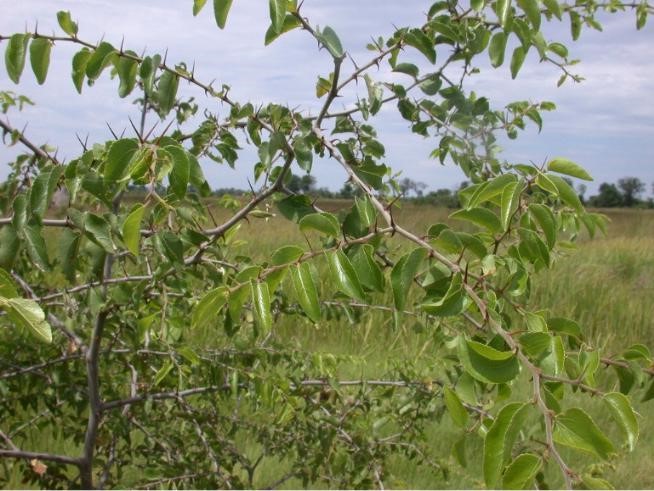In Southern Africa there is an attractive tree which people and animals love as it provides shade and delicious fruit. The morula tree is now known more widely because of an alcoholic liqueur that is sold commercially and many people still remember video footage of elephants behaving drunkenly after having eaten maybe a few too many fallen fruit. Morula is the Setswana name for the tree, other common names are, in South African English marula, maroela in Akfrikaans and nthula in Kalanga.
Sclerocarya birrea subsp. caffra (Sond.) Kokwaro is its scientificname. It is a member of the family Anacardiaceae, the same family as the mango, cashew, pistachio and sumac. The generic name Sclerocarya is derived from the Ancient Greek words ‘skleros’meaning ‘hard’ and ‘karyon’ meaning ‘nut’. The species name birrea is derived from ‘birr’ the common name of the tree in Senegal.
The morula is a medium sized to large deciduous tree with an erect trunk and rounded crown up to 15 meters in height. Male and Females are borne separately, but not always on separate trees, male plant flowers produce pollen and the female flowers produce the fruit. Bark pale silvery or purplish-gray on small individuals, and rough on large individuals, with flat roundish scales; crown rounded with rather dense foliage, spreading widely in large, old trees; the leaves cluster at the ends. The leaves are divided into 10 or more pairs of leaflets, dark green above and much paler below with tip narrowing to a sharp point. Flowers unisexual, borne in small clusters, with red sepals and yellow petals. Fruit is a drupe, green when unripe and turn yellow after ripening from January to June.
The fully ripe fruits have a mucilaginous texture with a sweetly acid but pleasant taste. The pulp can be used to prepare jam. The fruit is rich in vitamin C. The expressed juice makes an agreeable drink, and in many areas of southern Africa it is fermented into an alcoholic beverage, a fruit ‘beer’. The nut contains two or three seeds with oily and edible kernels which may also be used cosmetically. The white nut is highly nutritious and is eaten as it is or mixed with vegetables. Morula trees are widespread in Africa. It occurs naturally in various types of woodland, on sandy soil or occasionally sandy loam. It occurs throughout the eastern, south-eastern and northern parts of this country.
A variety of insects, including honey bees, pollinate the flowers. Elephants, giraffe, zebra and many others browse the leaves. Elephants can be destructive to the morula, as they will strip and feed on the bark. The tree bears a wealth of fruit which continue to be produced over a fairly long period of time, two months in personal experience. These are eaten (and enjoyed) by many living organisms, including humans. The larval stage of the beautiful pale-green African moon moth (Argema mimosa, a giant silk moth of the family Saturniidae) feeds on the leaves of the Morula.
The Morula tree has a wide variety of uses. Interestingly, traditionally in Botswana, the powdered bark is thought by some pregnant women to help determine the gender of an unborn baby. If a pregnant woman wishes to have a girl, she will take a preparation from the female plant and for a boy she will use the male plant. Across Africa, in traditional medicine, a decoction of the bark has been used to treat dysentery, diarrhoea, rheumatism and is considered to be a prophylactic effect against malaria. The bark is also reported to be an excellent remedy for haemorrhoids. While other combinations of the roots and bark are used as laxatives. In some localities a drink made from morula leaves is used for the treatment of gonorrhoea. Many of these traditional remedies are now being scientifically tested and proven effective, in vitro or in laboratory animal tests.
The bark, especially of the roots, but also of the trunk, is reportedly used as a remedy for snakebites. Pounded to a paste, it must be rubbed on the area until a swelling is raised, then a decoction of the bark is drunk, and a dressing applied over the area. The leaves may also be used for this purpose. The bark is used externally as an anti-inflammation preparation and, with butter added, is applied to the forehead for headache, and to the eyes for blepharitis. A decoction is used as a wash on skin-eruptions. The root is pounded up with water, and the water is drunk in the treatment of schistosomiasis. This water is also used for washing scabies, the fruit is said to be laxative, the leaves and fruits are chewed as a treatment for coughs. Chewing the fresh leaves and swallowing the juice helps with indigestion. All these traditional human uses of Morula bark make one wonder if the elephants in the Okavango delta who are stripping bark off Morula trees are, perhaps, medicating themselves!?
The wood is fairly soft and pale, it is used for traditional furniture, small curio carvings and household utensils like bowls and spoons. The wood does not crack easily and is used to make the pestles for traditional kika (mortar) to pound maize or sorghum. The wood is also suitable for drums and draught animal yokes. the inner layer of bark makes a strong rope. Red- brown dye can be produced from the fresh skin of the bark.
In many parts of Botswana, you will see that large Morula trees are often left standing alone in open fields. This is because of all their uses and their rather luxuriant shade when you are ploughing in hot November December before the rains. Then, come January and February, when you are weeding and hoeing the field your Morula tree may give you some refreshing fruit.
This article was written by Mr Mmusi Mmusi and Mrs Frances Murray-Hudson
If you would like to know more about the flora of Ngamiland or the work we do at PSUB herbarium, please contact us:
The Curator: Mr J. Madome: madome@ub.ac.bw
Herbarium Assistant: Mr. M. Mmusi: mmmusi@ub.ac.bw
PSUB Data Mobilization Project Assistant: Mrs. F. Murray-Hudson: fmurray-hudson@ub.ac.bw.
Photographs © Mr M. Mmusi and © F Murray-Hudson
Herbarium specimen image © PSUB Herbarium








0 Comment